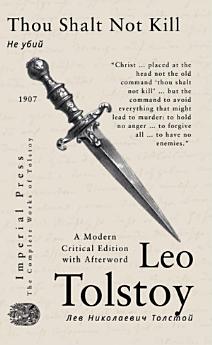Thou Shalt Not Kill
About this ebook
The text was banned in Russia, but when the Moscow publisher Obnovlenie tried to reprint it in 1906 the editor Nikolai Felten was jailed. Tolstoy answered with a new statement dated 5–18 August 1907 and titled “Не убий никого” (“Thou Shalt Not Kill Anyone,” often printed in English that year as “Thou Shalt Kill No One”). He denounced Felten’s arrest and the wave of executions and political shootings then sweeping Russia, arguing that government and revolutionaries alike had abandoned every moral restraint. The article went out in proof to several liberal papers; Slovo printed about a third of it on 6 September 1907, Golos Moskvy about half a week later, but all Russian newspapers cut passages the censors deemed seditious.
Abroad the 1900 version had already appeared as a one-penny Free Age Press leaflet translated by Aylmer Maude; that pamphlet was seized by German police at Russia’s request in 1903, yet Maude’s English text resurfaced in November 1907 in The Advocate of Peace and other journals. The complete Russian original of the 1907 revision did not reach print until 1917, when Posrednik issued it as a separate brochure. No philosophical authorities are cited beyond Scripture; Tolstoy’s sole acknowledged sources are Exodus 20:13 and the Sermon on the Mount, which he had been copying daily since the 1880s.
This critical reader's edition presents a modern translation of the original manuscript, crafted for the modern reader with clean, contemporary language and simplified sentence structures that clarify his complex Russian phrasing and specific antiquated references. Supplementary material enriches the text with autobiographical, historical, and linguistic context, including an afterword by the translator on Tolstoy’s personal history, impact, and intellectual legacy, an index of the philosophical concepts he employs—emphasizing Existentialism and influence by Schopenhauer—a comprehensive chronological list of his published writings, and a detailed timeline of his life, highlighting the personal relationships that shaped his philosophy.











